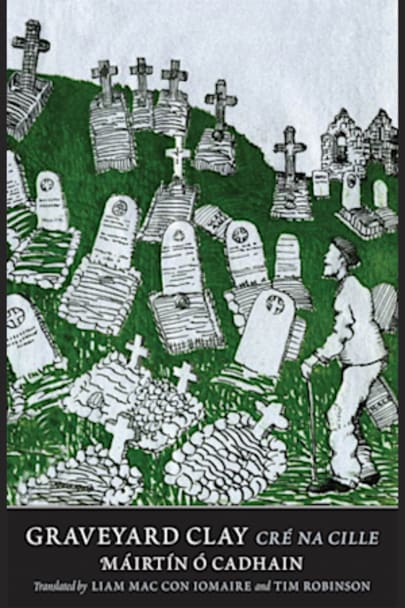In critical opinion and popular polls, Máirtín Ó Cadhain’s Graveyard Clay is invariably ranked the most important prose work in modern Irish. This bold new translation of his radically original Cré na Cille is the shared project of two fluent speakers of the Irish of Ó Cadhain’s native region, Liam Mac Con Iomaire and Tim Robinson. They have achieved a lofty goal: to convey Ó Cadhain’s meaning … accurately and to meet his towering literary standards. Graveyard Clay is a novel of black humor, reminiscent of the work of Synge and Beckett. The story unfolds entirely in dialogue as the newly dead arrive in the graveyard, bringing news of recent local happenings to those already confined in their coffins. Avalanches of gossip, backbiting, flirting, feuds, and scandal-mongering ensue, while the absurdity of human nature becomes ever clearer. This edition of Ó Cadhain’s masterpiece is enriched with footnotes, bibliography, publication and reception history, and other materials that invite further study and deeper enjoyment of his most engaging and challenging work.
more



Graveyard Clay (Cré na Cille) by Máirtín Ó Cadhain is set in a graveyard in the west of Ireland in the early 1940s and is a continuing dialogue between those buried there. These are not spirits waiting to be translated elsewhere but rather the coffin-bound corpses of the dead. They have brought with them into the afterlife the petty squabbles and animosities, injustices, pretensions and ambitions of their previous lives. Some hunger for news of the outside world, bedevilling new arrivals with questions about the goings on in the district and activities of their living family, friends and rivals. The voices are intermingled and unattributed; more often than not the conversations are one-sided.
The loudest voice of all is that of Caitríona Pháidín small-minded and petty, savouring old slights and ill-wishing those still above ground, most particularly her sister Nell, with whom she has a long standing feud, as well as her daughter-in-law. Caitríona is full of class consciousness, as are many others in the graveyard. While worrying over whether she has been buried in a prestigious Pound plot, a 15 shilling plot, or an ignominious half-guinea plot, she boasts to all who will listen about the cross of the best Island limestone that her son will raised over her grave. She is often angry that new comers are temporarily dumped in her grave because, without the cross, the gravediggers seem not to know she is there. She badgers all those who arrive in the graveyard for news of its progress, impatient and dismissive when they can give her no news to her liking or are more concerned with their own stories.
Other characters include Muraed Phroinsiais, Caitríona’s neighbour in life and in death; the school teacher, the Big Master, bitter that his younger wife married soon after his death; two men arguing about football; a murder victim; a solitary French airman shot down and buried in the graveyard, gradually learning Irish so he can speak with his cemetery neigbours; and a writer jealous to protect his literary position and legacy, among many many others.
Initially I found Graveyard Clay hard to get into. It was not so much the lack of attribution but the unfamiliarity of the names and their relationships to each other. I set the book aside for several months and when I came back to it, I was swept up by the flow of the language and no longer had problems identifying the speakers, recognizing them partly through their continuous preoccupations. There is little narrative structure with the inhabitants of the graveyard dwelling in an ongoing present. Their interactions and preoccupations reflect the human condition as they are no different in death than they were in life. The novel also reflects the life of those in remote rural areas of Ireland at the time and the hard struggle of survival.
I discovered Graveyard Clay when reading reviews of Lincoln in the Bardo. While both are set in graveyards and initially attribution of the speakers is a challenge, they are quite different books — both well worth reading. Graveyard Clay was published over sixty years earlier than Lincoln in the Bardo. Originally written in Irish, it was not translated into English for over sixty years when two translations were released within a year of each other, although it had been translated into Norwegian and Danish. I have chosen the 2016 translation by Liam Mac Con Iomaire and Tim Robinson as it was said to be a more literal translation. The 2015 translation by Alan Titley (titled Dirty Dust) is described as capturing the earthiness of rural characters. The examples of Titley’s translation that I have seen are, to my mind, unnecessarily crude although, no doubt, Dirty Dust is a more rollicking read than Graveyard Clay. I have never heard anyone’s granny speak like Titley’s Caitríona Pháidín.